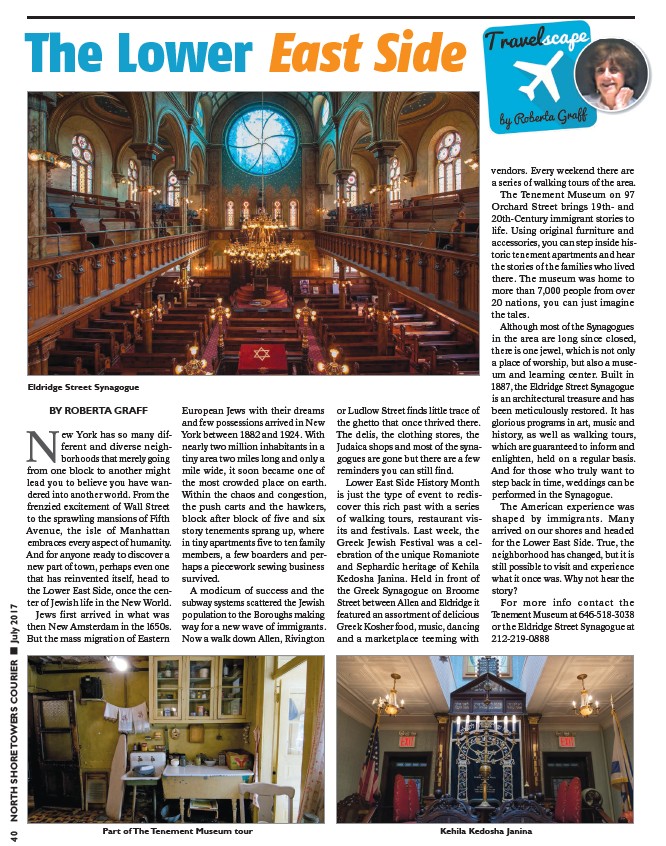
The Lower East Side
BY ROBERTA GRAFF
New York has so many different
and diverse neighborhoods
that merely going
from one block to another might
lead you to believe you have wandered
into another world. From the
frenzied excitement of Wall Street
to the sprawling mansions of Fifth
Avenue, the isle of Manhattan
embraces every aspect of humanity.
And for anyone ready to discover a
new part of town, perhaps even one
that has reinvented itself, head to
the Lower East Side, once the center
of Jewish life in the New World.
Jews first arrived in what was
then New Amsterdam in the l650s.
But the mass migration of Eastern
European Jews with their dreams
and few possessions arrived in New
York between 1882 and 1924. With
nearly two million inhabitants in a
tiny area two miles long and only a
mile wide, it soon became one of
the most crowded place on earth.
Within the chaos and congestion,
the push carts and the hawkers,
block after block of five and six
story tenements sprang up, where
in tiny apartments five to ten family
members, a few boarders and perhaps
a piecework sewing business
survived.
A modicum of success and the
subway systems scattered the Jewish
population to the Boroughs making
way for a new wave of immigrants.
Now a walk down Allen, Rivington
or Ludlow Street finds little trace of
the ghetto that once thrived there.
The delis, the clothing stores, the
Judaica shops and most of the synagogues
are gone but there are a few
reminders you can still find.
Lower East Side History Month
is just the type of event to rediscover
this rich past with a series
of walking tours, restaurant visits
and festivals. Last week, the
Greek Jewish Festival was a celebration
of the unique Romaniote
and Sephardic heritage of Kehila
Kedosha Janina. Held in front of
the Greek Synagogue on Broome
Street between Allen and Eldridge it
featured an assortment of delicious
Greek Kosher food, music, dancing
and a marketplace teeming with
vendors. Every weekend there are
a series of walking tours of the area.
The Tenement Museum on 97
Orchard Street brings 19th- and
20th-Century immigrant stories to
life. Using original furniture and
accessories, you can step inside historic
tenement apartments and hear
the stories of the families who lived
there. The museum was home to
more than 7,000 people from over
20 nations, you can just imagine
the tales.
Although most of the Synagogues
in the area are long since closed,
there is one jewel, which is not only
a place of worship, but also a museum
and learning center. Built in
1887, the Eldridge Street Synagogue
is an architectural treasure and has
been meticulously restored. It has
glorious programs in art, music and
history, as well as walking tours,
which are guaranteed to inform and
enlighten, held on a regular basis.
And for those who truly want to
step back in time, weddings can be
performed in the Synagogue.
The American experience was
shaped by immigrants. Many
arrived on our shores and headed
for the Lower East Side. True, the
neighborhood has changed, but it is
still possible to visit and experience
what it once was. Why not hear the
story?
For more info contact the
Tenement Museum at 646-518-3038
or the Eldridge Street Synagogue at
212-219-0888
Eldridge Street Synagogue
Part of The Tenement Museum tour Kehila Kedosha Janina 40 NORTH SHORE TOWERS COURIER ¢ July 2017